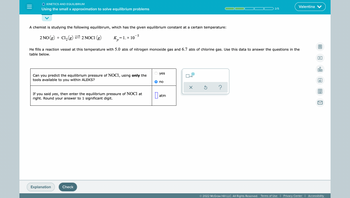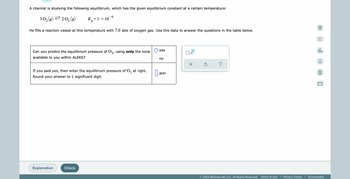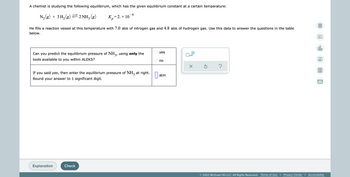
Chemistry
10th Edition
ISBN: 9781305957404
Author: Steven S. Zumdahl, Susan A. Zumdahl, Donald J. DeCoste
Publisher: Cengage Learning
expand_more
expand_more
format_list_bulleted
Question
What's the answer to this?

Transcribed Image Text:O KINETICS AND EQUILIBRIUM
=
Valentina V
Using the small x approximation to solve equilibrium problems
2/5
A chemist is studying the following equilibirum, which has the given equilibrium constant at a certain temperature:
-5
2 NO(g) + Cl₂(g) = 2 NOC1 (g)
K₂= 1. x 10
P
He fills a reaction vessel at this temperature with 5.0 atm of nitrogen monoxide gas and 6.7 atm of chlorine gas. Use this data to answer the questions in the
table below.
yes
x10
Can you predict the equilibrium pressure of NOC1, using only the
tools available to you within ALEKS?
no
X
Ś
?
If you said yes, then enter the equilibrium pressure of NOCI at
right. Round your answer to 1 significant digit.
atm
Explanation
Check
© 2022 McGraw Hill LLC. All Rights Reserved. Terms of Use | Privacy Center | Accessibility
A
000
Ar
B
KI
Expert Solution
This question has been solved!
Explore an expertly crafted, step-by-step solution for a thorough understanding of key concepts.
This is a popular solution
Trending nowThis is a popular solution!
Step by stepSolved in 2 steps with 2 images

Follow-up Questions
Read through expert solutions to related follow-up questions below.
Follow-up Question
I have a few more, heres one

Transcribed Image Text:"Synthesis gas" is a mixture of carbon monoxide and water vapor. At high temperature synthesis gas will form carbon dioxide and hydrogen, and in fact this
reaction is one of the ways hydrogen is made industrially.
A chemical engineer studying this reaction fills a 5.0 L flask with 3.3 atm of carbon monoxide gas and 1.4 atm of water vapor. When the mixture has come to
equilibrium she determines that it contains 2.2 atm of carbon monoxide gas, 0.30 atm of water vapor and 1.1 atm of carbon dioxide.
The engineer then adds another 0.35 atm of water, and allows the mixture to come to equilibrium again. Calculate the pressure of hydrogen after equilibrium is
reached the second time. Round your answer to 2 significant digits.
atm
Dx1
x10
X
5
?
Explanation
© 2022 McGraw Hill LLC. All Rights Reserved. Terms of Use | Privacy Center | Accessibility
Check
A
000
Ar
81
K
Solution
by Bartleby Expert
Follow-up Question
This is my last one, thanks!

Transcribed Image Text:A chemist is studying the following equilibirum, which has the given equilibrium constant at a certain temperature:
6
30₂(g)=203 (g)
= 1. × 10
He fills a reaction vessel at this temperature with 7.0 atm of oxygen gas. Use this data to answer the questions in the table below.
▷
yes
000
x10
Can you predict the equilibrium pressure of 03, using only the tools
available to you within ALEKS?
no
Ar
X
Ś ?
If you said yes, then enter the equilibrium pressure of O3 at right.
Round your answer to 1 significant digit.
atm
Explanation
Check
© 2022 McGraw Hill LLC. All Rights Reserved. Terms of Use | Privacy Center | Accessibility
Bp
0:
Solution
by Bartleby Expert
Follow-up Question
this is my next question

Transcribed Image Text:A chemist is studying the following equilibirum, which has the given equilibrium constant at a certain temperature:
6
N₂(g) + 3 H₂(g) ⇒ 2NH3 (g)
K₂=2. × 10
р
He fills a reaction vessel at this temperature with 7.0 atm of nitrogen gas and 4.8 atm of hydrogen gas. Use this data to answer the questions in the table
below.
yes
Can you predict the equilibrium pressure of NH3, using only the
tools available to you within ALEKS?
x10
no
X
Ś
?
If you said yes, then enter the equilibrium pressure of NH3 at right.
Round your answer to 1 significant digit.
atm
Explanation
Check
© 2022 McGraw Hill LLC. All Rights Reserved. Terms of Use | Privacy Center | Accessibility
0:
A
Ar
|
Solution
by Bartleby Expert
Follow-up Question
The correct answer was 0.04, but thanks sm!
Solution
by Bartleby Expert
Follow-up Questions
Read through expert solutions to related follow-up questions below.
Follow-up Question
I have a few more, heres one

Transcribed Image Text:"Synthesis gas" is a mixture of carbon monoxide and water vapor. At high temperature synthesis gas will form carbon dioxide and hydrogen, and in fact this
reaction is one of the ways hydrogen is made industrially.
A chemical engineer studying this reaction fills a 5.0 L flask with 3.3 atm of carbon monoxide gas and 1.4 atm of water vapor. When the mixture has come to
equilibrium she determines that it contains 2.2 atm of carbon monoxide gas, 0.30 atm of water vapor and 1.1 atm of carbon dioxide.
The engineer then adds another 0.35 atm of water, and allows the mixture to come to equilibrium again. Calculate the pressure of hydrogen after equilibrium is
reached the second time. Round your answer to 2 significant digits.
atm
Dx1
x10
X
5
?
Explanation
© 2022 McGraw Hill LLC. All Rights Reserved. Terms of Use | Privacy Center | Accessibility
Check
A
000
Ar
81
K
Solution
by Bartleby Expert
Follow-up Question
This is my last one, thanks!

Transcribed Image Text:A chemist is studying the following equilibirum, which has the given equilibrium constant at a certain temperature:
6
30₂(g)=203 (g)
= 1. × 10
He fills a reaction vessel at this temperature with 7.0 atm of oxygen gas. Use this data to answer the questions in the table below.
▷
yes
000
x10
Can you predict the equilibrium pressure of 03, using only the tools
available to you within ALEKS?
no
Ar
X
Ś ?
If you said yes, then enter the equilibrium pressure of O3 at right.
Round your answer to 1 significant digit.
atm
Explanation
Check
© 2022 McGraw Hill LLC. All Rights Reserved. Terms of Use | Privacy Center | Accessibility
Bp
0:
Solution
by Bartleby Expert
Follow-up Question
this is my next question

Transcribed Image Text:A chemist is studying the following equilibirum, which has the given equilibrium constant at a certain temperature:
6
N₂(g) + 3 H₂(g) ⇒ 2NH3 (g)
K₂=2. × 10
р
He fills a reaction vessel at this temperature with 7.0 atm of nitrogen gas and 4.8 atm of hydrogen gas. Use this data to answer the questions in the table
below.
yes
Can you predict the equilibrium pressure of NH3, using only the
tools available to you within ALEKS?
x10
no
X
Ś
?
If you said yes, then enter the equilibrium pressure of NH3 at right.
Round your answer to 1 significant digit.
atm
Explanation
Check
© 2022 McGraw Hill LLC. All Rights Reserved. Terms of Use | Privacy Center | Accessibility
0:
A
Ar
|
Solution
by Bartleby Expert
Follow-up Question
The correct answer was 0.04, but thanks sm!
Solution
by Bartleby Expert
Knowledge Booster
Learn more about
Need a deep-dive on the concept behind this application? Look no further. Learn more about this topic, chemistry and related others by exploring similar questions and additional content below.Similar questions
- Complete reagent tablearrow_forwardI had gotten this one incorrect, but i wanted to use it to study, so please give me the solution to all parts of this question.arrow_forwardMethane is oxidized in the atmosphere by photochemical reaction. Write the chemical equation of this reaction?_CH4 + O2 CH2O + H2OCH4 + O H3C. + H. + O.CH4 + O CH3C. + HO.CH4 + O .CH3 + HO.arrow_forward
- The name carbohydrate comes from the fact that many simple sugars have chemical formulae that look like water has simply been added to carbon. (The suffix hydrate from the Greek word hydor ("water") means "compound formed by the addition of water.") The actual chemical structure of carbohydrates doesn't look anything like water molecules bonded to carbon atoms (see sketch at right). But it is nevertheless possible to chemically extract all the hydrogen and oxygen from many simple carbohydrates as water, leaving only carbon behind. If you search the Internet for "reaction of sulfuric acid and sugar" you will find some impressive videos of this. Suppose you had 300.g of ordinary table sugar, which chemists call sucrose, and which has the chemical formula C12H22O11 . Calculate the maximum mass of water you could theoretically extract. Be sure your answer has a unit symbol, and round it to the correct number of significant digits.arrow_forwardDescribe an experiment's results you will carry out : Ethanol (Alcohol) 1-bromoethane (Halogenoalkane) Ethanal (aldehyde) Carry out your experiment and identify substances X, Y and Z. The unknown substances provided are Ethanol, 1-bromoethane and Ethanal.arrow_forwarda) b) What is the conjugate acid of NH3? What is the conjugate base of H2O?arrow_forward
- Given the following data: 2 H₂(g) + O₂(g) → 2 H₂O(g) C₂H4(g) + 3 O₂(g) → 2 CO₂(g) + 2 H₂O(g) 2 CzHo(g) +7 Oz(9) → 4 CO,(g) + 6 H20(g) calculate AH for the reaction C₂H₂(g) + H₂(g) → C₂H₂(g). kJ ΔΗ = −484 kJ AH-1323 kJ ΔΗ = -2857 kJarrow_forwardQ.02: Write the structure of benzil, benzoin and hydrobenzoin. Q.03: Write the name of two common reducing agents for organic compounds.arrow_forwardC₁H12 + 802(g) →→ 5CO2(g) + 6H₂O (1)arrow_forward
Recommended textbooks for you
 ChemistryChemistryISBN:9781305957404Author:Steven S. Zumdahl, Susan A. Zumdahl, Donald J. DeCostePublisher:Cengage Learning
ChemistryChemistryISBN:9781305957404Author:Steven S. Zumdahl, Susan A. Zumdahl, Donald J. DeCostePublisher:Cengage Learning ChemistryChemistryISBN:9781259911156Author:Raymond Chang Dr., Jason Overby ProfessorPublisher:McGraw-Hill Education
ChemistryChemistryISBN:9781259911156Author:Raymond Chang Dr., Jason Overby ProfessorPublisher:McGraw-Hill Education Principles of Instrumental AnalysisChemistryISBN:9781305577213Author:Douglas A. Skoog, F. James Holler, Stanley R. CrouchPublisher:Cengage Learning
Principles of Instrumental AnalysisChemistryISBN:9781305577213Author:Douglas A. Skoog, F. James Holler, Stanley R. CrouchPublisher:Cengage Learning Organic ChemistryChemistryISBN:9780078021558Author:Janice Gorzynski Smith Dr.Publisher:McGraw-Hill Education
Organic ChemistryChemistryISBN:9780078021558Author:Janice Gorzynski Smith Dr.Publisher:McGraw-Hill Education Chemistry: Principles and ReactionsChemistryISBN:9781305079373Author:William L. Masterton, Cecile N. HurleyPublisher:Cengage Learning
Chemistry: Principles and ReactionsChemistryISBN:9781305079373Author:William L. Masterton, Cecile N. HurleyPublisher:Cengage Learning Elementary Principles of Chemical Processes, Bind...ChemistryISBN:9781118431221Author:Richard M. Felder, Ronald W. Rousseau, Lisa G. BullardPublisher:WILEY
Elementary Principles of Chemical Processes, Bind...ChemistryISBN:9781118431221Author:Richard M. Felder, Ronald W. Rousseau, Lisa G. BullardPublisher:WILEY

Chemistry
Chemistry
ISBN:9781305957404
Author:Steven S. Zumdahl, Susan A. Zumdahl, Donald J. DeCoste
Publisher:Cengage Learning

Chemistry
Chemistry
ISBN:9781259911156
Author:Raymond Chang Dr., Jason Overby Professor
Publisher:McGraw-Hill Education

Principles of Instrumental Analysis
Chemistry
ISBN:9781305577213
Author:Douglas A. Skoog, F. James Holler, Stanley R. Crouch
Publisher:Cengage Learning

Organic Chemistry
Chemistry
ISBN:9780078021558
Author:Janice Gorzynski Smith Dr.
Publisher:McGraw-Hill Education

Chemistry: Principles and Reactions
Chemistry
ISBN:9781305079373
Author:William L. Masterton, Cecile N. Hurley
Publisher:Cengage Learning

Elementary Principles of Chemical Processes, Bind...
Chemistry
ISBN:9781118431221
Author:Richard M. Felder, Ronald W. Rousseau, Lisa G. Bullard
Publisher:WILEY